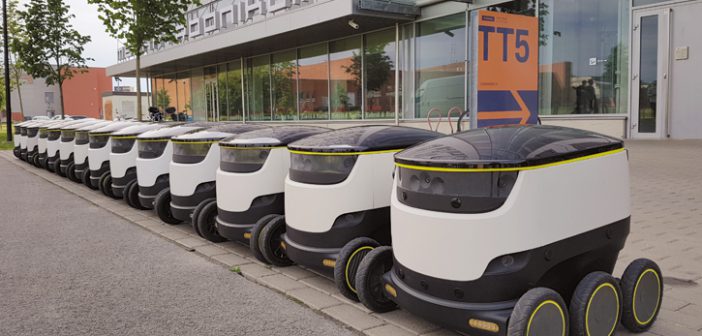Sharing the sidewalk with a semi-autonomous robot can be a curious affair. Some pedestrians have tried blocking its path to test its navigational skills; one youngster even tried to feed it a banana. Still, in cities like Washington, D.C., and London, where the ordinary and the illogical routinely share the sidewalks, most are nonplussed by a robot that resembles a tricked-out cooler on six wheels.
That’s a good thing, according to Starship Technologies Chief Operating Officer Allan Martinson, who believes the future of last mile deliveries lies with these “wheeling voyagers. Robots will transform short-distance deliveries in cities where traffic congestion tends to cripple economies of scale,” Martinson says.
“On-demand delivery costs are expensive and they require humans. Using the robots literally puts the package on wheels and strips a ton of cost out of the equation.”
The startup, created by two of Skype’s co-founders, Ahti Heinla and Janus Friis, aims to create fleets of the small delivery robots across the globe.
“Our vision revolves around three zeroes — zero cost, zero waiting time and zero environmental impact,” Heinla says. “We want to do to local deliveries what Skype did to telecommunications.”
Tracking capabilities
Starship launched pilot projects in Washington, D.C., and Redwood, Calif., in February; the company began testing last year in cities in Estonia, Switzerland, Germany and the United Kingdom, home of the company’s business headquarters. Partners vary by location; in the United States, the startup is working with DoorDash and Postmates.
The robotic delivery system, equipped with GPS, computer vision and proprietary mapping techniques, can pinpoint exact locations to the nearest inch.
“Robots will transform short-distance deliveries in cities where traffic congestion tends to cripple economies of scale.”
— Allan Martinson, Starship Technologies
Outfitted with nine cameras and ultrasonic sensors to detect obstacles, the robot yields for pedestrians, cyclists, wheelchairs and dogs. It weighs about 40 pounds without cargo and can carry up to 20 pounds. The robot can move at a speed of 10 miles per hour, but it generally rolls along at pedestrian speed — more akin to 4 miles per hour.
The robots are monitored at all times; if someone tries to snatch it from its path or steal the contents, they’re likely to be quickly intercepted.
“We’ve had instances where someone tries to pick up the robot,” Martinson says. “They don’t get very far. We know where the robots are at all times. The robot is like a big homing beacon.” Users can track the robot’s location in real time through a smartphone app; once the parcel arrives, the person receiving the delivery can unlock the cargo with a code sent via text message.
Lower energy costs
While there is plenty of industry buzz about using drones for package delivery, Martinson says the robots are better suited for cities and suburbs where they can roll along the sidewalks, and feels that the drones are more appropriate for remote, rural areas.
“There are notable differences between the two. Drones require more energy and must be equipped with a bigger battery. The maximum amount of weight they can lift and carry is about 5 pounds. Drones are expensive to build and they’re not permitted to fly everywhere,” he says.
“The Starship robots are rolling, which translates into less energy used — and we’re building them as cost-effectively as we’re able to, to provide greater accessibility.”
With numerous tests ongoing, Martinson is upbeat about the future. “In the areas where we’ve tested the robots, they quickly become part of the urban infrastructure. We’re giving local businesses and grocery stores a chance to free up employees from deliveries, and reduce costs too.”
BY SUSAN REDA

